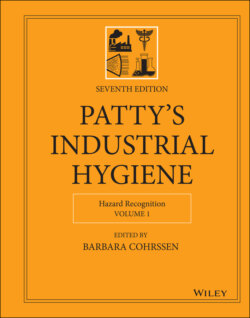Читать книгу Patty's Industrial Hygiene, Hazard Recognition - Группа авторов - Страница 124
6.1 Participatory EHS and Risk Communication
ОглавлениеSuccessful EHS performance is often based on lagging indicators like frequency rates and lost time work‐related injury and illness. Often ignored are the attitudes and perceptions of workers in this process, an essential component of a healthy and safe work climate. Participation at work is a general technique of giving employees an opportunity to control the design of their workplace and plan their work activities. Participatory EHS is an expansion of this strategy, integrating workers into the thought processes of the field practitioners and harnessing their input toward the development of an EHS program. With a common language for discussing workplace hazards and controls in hand, this multidisciplinary process provides a mutual communication of risk and identification of solutions that can also become a powerful management tool (45). Worker attitudes toward accident and incident prevention in relation to management commitment and level of involvement are important for promoting safe workplaces. Appropriate risk perception was found to be significantly correlated to risk behavior and is related to the occurrence of accidents and near misses (46). Therefore, an employee's safe work attitude can be positively influenced when they consider themselves an integral part of a safety culture approach. This attitude is enhanced with a participatory EHS program, itself becoming a measurable performance indicator of a successful safe and healthy workplace (47).
Though worker participation in reducing workplace hazards is often called for in research, underlying ideologies of management control and worker empowerment need to be fully understood to ensure a long‐lasting participation in practice over time (14, 48). Participatory approaches focusing on worker input to achieve good practices and acceptable controls have an excellent track record of successful implementation over time and for establishing improvements in technical areas including materials handling, risk assessment, and comprehensive work organization (49, 50). Once participatory methods for developing risk assessments are in practice, ongoing facilitation with training tools, checklists, and group involvement assists in maintaining and evaluating these applications positively (50).
The RLBMS is, therefore, the nexus of the participatory approach toward workplace risk management and risk communication, where EHS discipline expertise and collective worker input meet. Building an effective corporation requires this comprehensive feedback approach as it tears down existing preconceptions, rules, and institutional customs in order to build a more effective and functional EORM system (51, 52). EHS field practitioners have an innate understanding of the workforce that is necessary to identify existing practices and organizational structures to determine the correct organizational direction. EHS disciplines are also in an appropriate position to promote a positive course for management to enhance their organization. Conversely, with a lack of productivity and profitability identified in an existing EORM system, EHS disciplines must also identify these weaknesses to ensure the negative organizational direction does not persist. Participatory methods in the collective redefining and rebuilding of an EHS organizational structure has been shown to achieve the risk communication necessary to receive the buy‐in of managers and workers alike, as this approach assists in achieving a collective vision of the ideals, objectives, and goals of a successful, organizationally‐specific, EORM.
